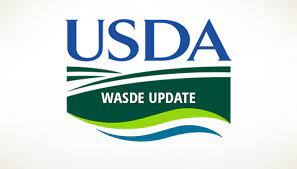LIVESTOCK & POULTRY: Estimates of 2021 red meat, poultry, and egg production are adjusted to reflect December production data. The 2022 forecast for total red meat and poultry production is lowered slightly from last month, as higher forecast beef production is more than offset by lower pork, broiler, and turkey production.
The beef production forecast is raised from the previous month as larger expected placements during first-half 2022 are marketed in the latter half of the year. However, the increase in fed cattle slaughter is partly offset by lower non-fed cattle slaughter. Pork production is lowered on a slower pace of slaughter. Broiler and turkey production forecasts are reduced on current hatchery data and higher expected feed costs.
Livestock, poultry, and egg trade estimates for 2021 are adjusted to reflect December trade data. For 2022, the beef import forecast is raised on strong demand for processing beef; the export forecast is unchanged. Pork exports are reduced on continued weakness in demand from China and increased competition in other markets. The broiler export forecast is lowered on weaker demand from a number of Asian markets. The turkey export forecast is reduced from last month on slower demand.
Fed-cattle prices are raised for the second half of the year on firm packer demand. Hog, broiler, turkey, and egg price forecasts are raised on current prices and slower growth of production expected during the year.
COARSE GRAINS: This month’s 2021/22 U.S. corn supply and use is unchanged relative to last month. The season-average farm price remains at $5.45 per bushel. Global coarse grain production for 2021/22 is projected 2.7 million tons lower to 1,497.4 million. This month’s foreign coarse grain outlook is for lower production and consumption, and smaller ending stocks relative to last month. Foreign corn production is lower, mostly reflecting declines for Brazil and Paraguay that are partially offset by an increase for the Philippines. Brazil corn production is reduced based on lower yield expectations for first crop corn. Paraguay corn production is down as extreme heat and dryness sharply reduce yield prospects. Foreign barley production is reduced reflecting declines for Iraq and Syria. Major global coarse grain trade changes for 2021/22 include lower corn exports for Paraguay. For 2020/21, Argentina and Brazil’s exports for the marketing year beginning in March 2021 are raised based on observed shipments to date. For 2021/22, corn imports are raised for Iran and Canada. Barley exports are increased for the EU, with higher imports projected for China but lowered for Saudi Arabia. Foreign corn ending stocks are down, mostly reflecting a forecast reduction for Brazil that is partly offset by an increase for Argentina. Global corn stocks, at 302.2 million tons, are down 0.9 million.
WHEAT: The outlook for 2021/22 U.S. wheat this month is for stable supplies, lower domestic use, reduced exports, and higher ending stocks. Food use is lowered 3 million bushels to 959 million with durum accounting for the entire reduction. This is primarily based on the latest NASS Flour Milling Products report. Seed use is revised downward 2 million bushels to 64 million on the incorporation of NASS seed use data for the first two quarters of the marketing year. Seed use is also revised for the previous two years with updated NASS data. Exports are lowered 15 million bushels to 810 million on slowing export sales and shipments with reductions for Hard Red Winter and White. Projected 2021/22 ending stocks are raised 20 million bushels to 648 million but are still 23 percent lower than last year. The projected season-average farm price (SAFP) is raised $0.15 per bushel to $7.30 on NASS prices reported to date and expectations for cash and futures prices for the remainder of 2021/22. This would be the highest SAFP since 2012/13. The global wheat outlook for 2021/22 is for lower supplies, higher consumption, increased trade, and reduced ending stocks. Supplies are projected falling by 1.1 million tons to 1,066.3 million as reduced production more than offsets higher beginning stocks.














